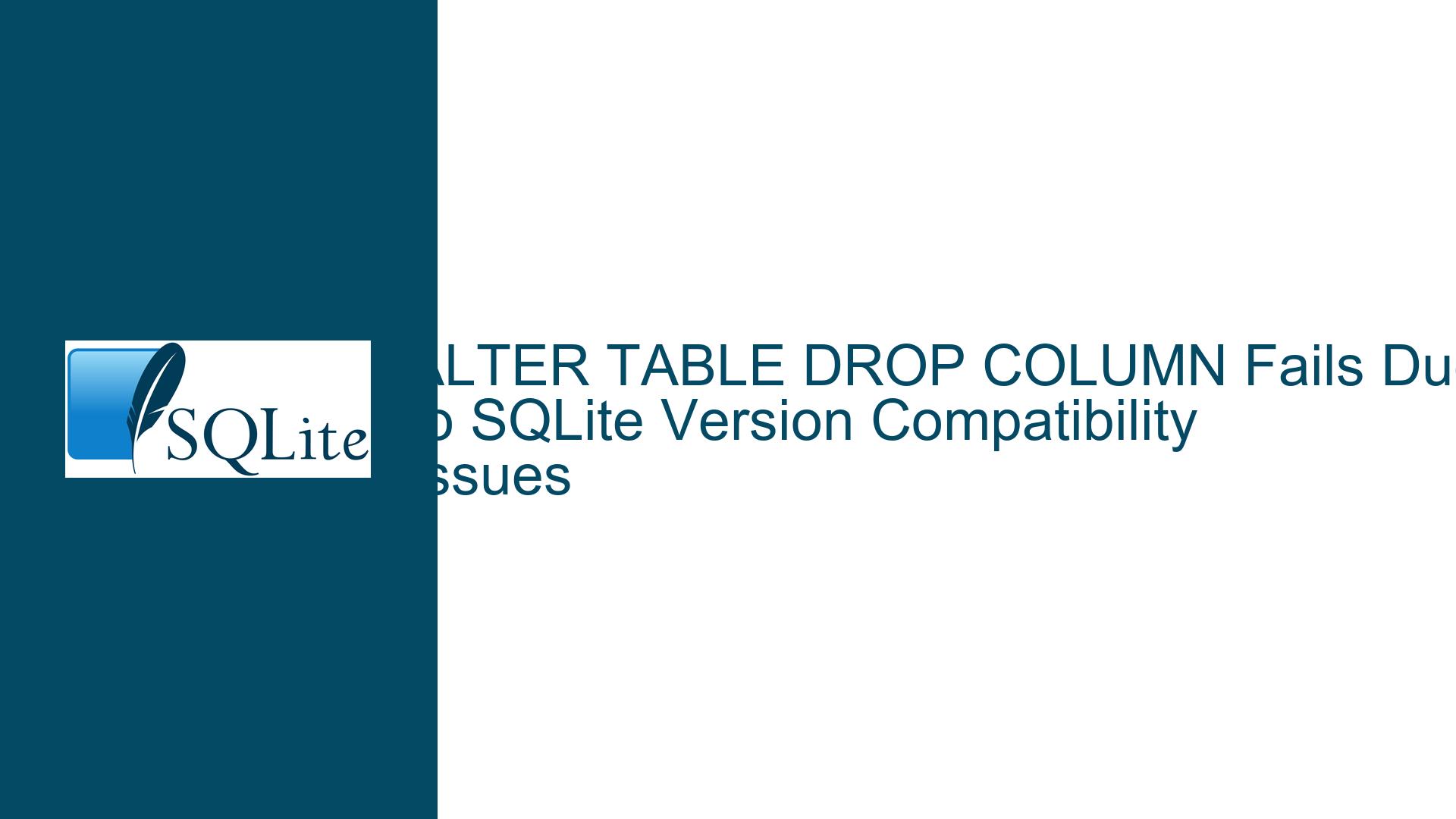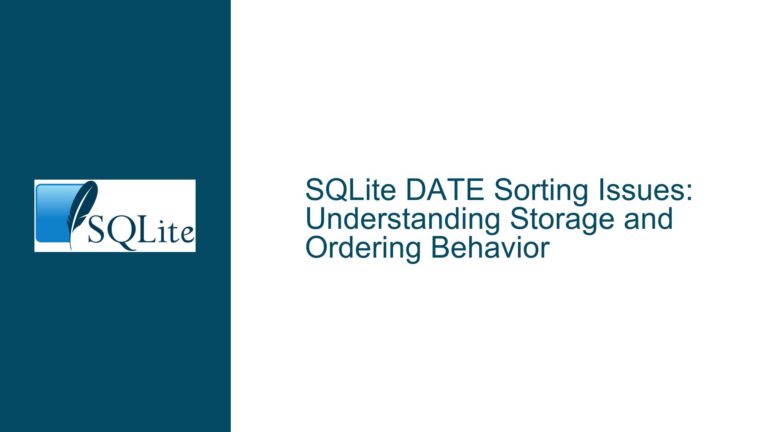ALTER TABLE DROP COLUMN Fails Due to SQLite Version Compatibility Issues
Understanding ALTER TABLE DROP COLUMN Behavior Across SQLite Versions
The execution of the ALTER TABLE tablename DROP COLUMN colname statement in SQLite can yield inconsistent results depending on the version of the SQLite3 library in use. A syntax error such as near "DROP": syntax error indicates that the SQL parser does not recognize the DROP COLUMN clause. This discrepancy arises from fundamental differences in how SQLite versions handle schema modifications. Prior to version 3.35.0 (released March 12, 2021), SQLite lacked native support for dropping columns directly via the ALTER TABLE command. Versions 3.35.0 and later introduced this capability, aligning SQLite with other database systems that support this operation. The error occurs when attempting to use DROP COLUMN in versions older than 3.35.0, where the parser treats DROP as an invalid keyword in the context of ALTER TABLE.
The root of this issue lies in SQLite’s historical approach to schema modifications. Unlike databases such as PostgreSQL or MySQL, SQLite traditionally required developers to use a multi-step process to remove columns: creating a new table without the target column, copying data from the old table to the new one, dropping the old table, and renaming the new table. This workflow was necessary because SQLite’s ALTER TABLE implementation was limited to renaming tables or adding columns. The introduction of DROP COLUMN in 3.35.0 simplified this process but created backward compatibility challenges. Applications or tools relying on older SQLite versions will fail to parse the DROP COLUMN syntax, leading to errors that disrupt automated schema migration scripts or manual database maintenance tasks.
To diagnose the problem, the first step is to identify the SQLite version in use. The function SELECT sqlite_version(); returns the runtime library version, which may differ from the expected version if the environment uses multiple installations or linked libraries. For example, a system might have SQLite 3.34.0 installed globally while an application uses an embedded SQLite 3.36.0 library. Discrepancies between the expected and actual versions explain why the same SQL statement succeeds in one environment but fails in another. Developers must also consider that some frameworks or programming languages bundle specific SQLite versions, which may not match the system-wide installation.
Root Causes of Syntax Errors When Dropping Columns in SQLite
The immediate cause of the near "DROP": syntax error is the absence of the DROP COLUMN clause in SQLite versions predating 3.35.0. SQLite’s parser uses a tokenizer and grammar rules defined at compile-time, meaning that newer syntax elements like DROP COLUMN are unrecognized in older versions. When the parser encounters an unfamiliar keyword or clause, it raises a syntax error. This behavior is not unique to DROP COLUMN; it applies to any SQLite feature introduced after the library’s release. For instance, CREATE TABLE enhancements or new window function syntax would similarly fail in older versions.
Another contributing factor is the misconception that SQLite supports full ALTER TABLE operations comparable to other databases. Developers familiar with PostgreSQL or MySQL might assume that DROP COLUMN is universally available, leading to errors when porting schema scripts to SQLite without version checks. Furthermore, SQLite’s documentation emphasizes its “zero-configuration” design, which can create a false sense of uniformity across environments. In reality, SQLite’s capabilities are tightly coupled to its version, and subtle differences in syntax or behavior can cause unexpected failures.
The error can also arise from misconfigured development or deployment environments. For example, a developer might test a schema migration script using SQLite 3.40.0 locally but deploy it to a production server running SQLite 3.30.0. This version mismatch is particularly common in containerized environments or when using precompiled binaries that include an outdated SQLite library. Similarly, programming languages like Python or Node.js may bundle SQLite as part of their standard libraries, with versions that lag behind the official SQLite releases. The sqlite3 module in Python, for instance, links against the SQLite version present on the system at compile-time, which may not match the latest upstream release.
Resolving DROP COLUMN Errors and Ensuring Schema Compatibility
To resolve the DROP COLUMN syntax error, developers must first confirm the SQLite version using SELECT sqlite_version();. If the version is older than 3.35.0, there are two primary solutions: upgrading the SQLite library or using the legacy column removal workflow. Upgrading SQLite is the recommended approach for systems where the library can be replaced without breaking dependencies. On Linux systems, this may involve installing updated packages or compiling SQLite from source. For embedded systems or applications that bundle SQLite, updating the library requires recompiling the application with the newer SQLite source code.
If upgrading is not feasible, the legacy method for column removal must be employed. This involves creating a new table without the target column, copying data from the old table, dropping the old table, and renaming the new table. The steps are as follows:
- Disable foreign key constraints temporarily using
PRAGMA foreign_keys=OFF;to prevent errors during the table reconstruction. - Begin a transaction with
BEGIN TRANSACTION;to ensure atomicity. - Create the new table with the desired schema, excluding the column to be dropped.
- Copy data from the old table to the new table using
INSERT INTO new_table SELECT col1, col2, ... FROM old_table;, explicitly listing the columns to retain. - Drop the old table with
DROP TABLE old_table;. - Rename the new table to the original name using
ALTER TABLE new_table RENAME TO old_table;. - Rebuild indexes, triggers, and views that referenced the old table.
- Commit the transaction with
COMMIT;and re-enable foreign key constraints withPRAGMA foreign_keys=ON;.
This process must be customized for each schema, accounting for indexes, triggers, and foreign key constraints. Tools like sqlite3 command-line shell or ORM libraries can automate parts of this workflow, but manual validation is essential to ensure data integrity. Developers should also consider writing idempotent migration scripts that check for the existence of columns before attempting to drop them, using queries against the sqlite_master table and PRAGMA table_info(table_name); to inspect the schema programmatically.
For cross-version compatibility, applications should include runtime checks for SQLite version and conditionally execute DROP COLUMN or fall back to the legacy method. For example:
SELECT CASE
WHEN sqlite_version() >= '3.35.0' THEN
'ALTER TABLE tablename DROP COLUMN colname;'
ELSE
-- Generate legacy migration steps
END;
This approach ensures that schema migrations adapt to the runtime environment, minimizing errors. Additionally, developers should document the minimum required SQLite version for their applications and include version checks in installation or setup scripts to alert users of incompatibilities.
In scenarios where third-party tools or frameworks abstract SQLite interactions, consult the documentation to determine how they handle schema migrations. Some ORMs, like Django’s migrations framework, automatically generate appropriate SQL based on the detected SQLite version, while others may require manual intervention. Testing migrations across all supported SQLite versions is critical to identifying regressions or compatibility issues early in the development cycle.
By understanding SQLite’s version-specific behavior and adopting proactive compatibility measures, developers can avoid syntax errors and ensure robust schema management across diverse environments.






